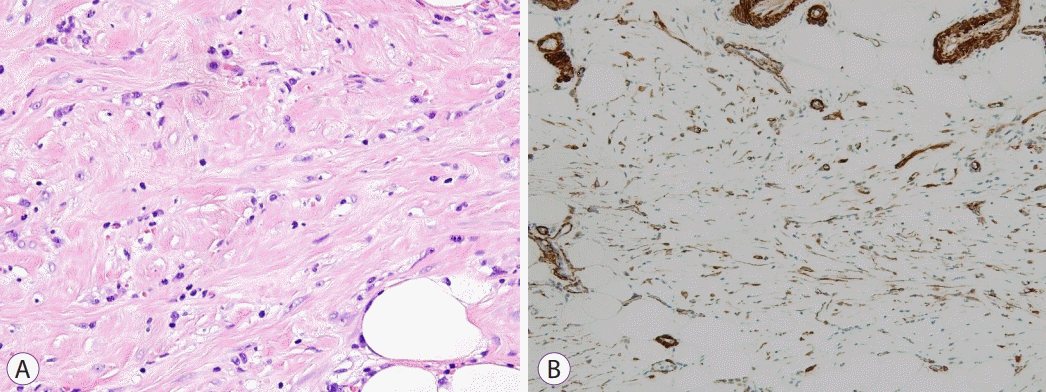A 43-year-old woman presented with a gastric subepithelial tumor incidentally detected during screening endoscopy (Fig. 1A). On follow-up endoscopy 6 months later, the tumor was seen at the posterior wall of the lower body and had increased in size compared with measurements obtained from the previous endoscopy; however, no erosion or ulceration was noted (Fig. 1B). When pressed upon with biopsy forceps, the tumor was found to be hard and unmovable. On endoscopic ultrasonography, the tumor measured 1.5 cm and had a heterogeneously hypoechoic appearance in the deep mucosal and submucosal layers (Fig. 1C). An examination of the specimen obtained from endoscopic biopsy revealed only chronic gastritis. Because the size of the tumor had increased, suggesting malignancy, endoscopic submucosal dissection was performed (Fig. 1D).
What is the most likely diagnosis?
Histopathological examination of the resected specimen revealed spindle tumor cells under myxoid stroma with lymphoplasmacytic infiltration among the tumor cells (Fig. 2A). The spindle cells were immunopositive for smooth muscle actin and vimentin (Fig. 2B) and immunonegative for chromogranin, S-100, C-kit, DOG1, and anaplastic lymphoma kinase (ALK). Based on these findings, a diagnosis of an inflammatory myofibroblastic tumor of the stomach was made. Because the tumor was completely resected with endoscopic submucosal dissection, further treatment was not pursed. No signs of recurrence or metastasis were found during the 18-month follow-up visit.
Inflammatory myofibroblastic tumors are rare mesenchymal tumors with an undetermined behavior that preferentially occur in children and young adults. They most commonly occur in the lungs, mesenteries, omentum, and retroperitoneum [1]. Inflammatory myofibroblastic tumors involving the stomach are extremely rare. The pathogenesis of inflammatory myofibroblastic tumors remains unclear, although various allergic, immunologic, and infectious mechanisms have been postulated [2].
Because gastric inflammatory myofibroblastic tumors localize in the submucosa, endoscopic biopsy usually reveals only chronic gastritis. Thus, surgical resection with adequate margins is the most reliable diagnostic and treatment method. However, as in the present case, endoscopic submucosal dissection can be an alternative diagnostic and treatment modality in selected cases. Although hematogenous metastasis has not been reported, inflammatory myofibroblastic tumors have an intermediate biological potential with frequent local recurrence [3]. Therefore, resection with adequate margins in addition to regular mandatory follow-up to is the best treatment option.
REFERENCES
1. Shi H, Wei L, Sun L, Guo A. Primary gastric inflammatory myofibroblastic tumor: a clinicopathologic and immunohistochemical study of 5 cases. Pathol Res Pract. 2010; 206:287–291.

2. Cook JR, Dehner LP, Collins MH, et al. Anaplastic lymphoma kinase (ALK) expression in the inflammatory myofibroblastic tumor: a comparative immunohistochemical study. Am J Surg Pathol. 2001; 25:1364–1371.
Fig. 1.
(A) Initial endoscopy reveals a small subepithelial tumor at the gastric lower body. (B) On follow-up endoscopy 6 months later, the tumor has increased in size, but no erosion or ulceration is noted. (C) On endoscopic ultrasonography, the tumor is a 1.5 cm-sized, heterogeneously hypoechoic lesion in the deep mucosal and submucosal layers. (D) The resected specimen after endoscopic submucosal dissection.

Fig. 2.
(A) Histopathological examination reveals spindle tumor cells under myxoid stroma with lymphoplasmacytic infiltration among the tumor cells (hematoxylin and eosin, ×400). (B) The spindle cells are immunopositive for smooth muscle actin and vimentin, and immunonegative for chromogranin, S-100, C-kit, DOG1, and anaplastic lymphoma kinase (smooth muscle actin, ×200).





 PDF
PDF Citation
Citation Print
Print



 XML Download
XML Download